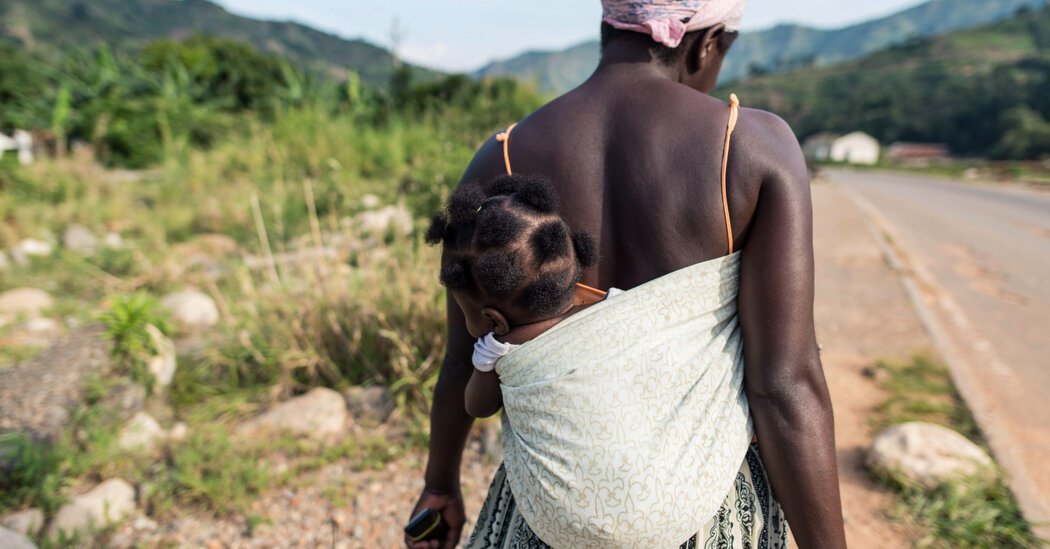As an American medical resident in a global health program in Uganda 12 years ago, Dr. Ross Boyce saw the devastating toll of malaria firsthand. About half of the patients he saw in a rural clinic had the disease. Most were very young children; many recovered with treatment, but some did not survive.
Dr. Boyce noticed something else: All of the Ugandan mothers carried their babies tied on their backs with a wide piece of cotton. And this made him think about the clothing he wore long before medical school, when he was deployed to Iraq as an infantry officer: the U.S. military treated his uniforms with permethrin, a long-acting insecticide, to protect against mosquito-borne illnesses.
Dr. Boyce floated an idea among his Ugandan colleagues: Could they treat baby wraps in insecticides too? Might that keep mosquitoes away from babies?
One colleague thought it was worth a try. They needed new solutions, said Dr. Edgar Mulogo, a professor of public health at Mbarara University of Science and Technology, because progress against malaria had stalled.
The remarkable results of that brainstorming session were published recently in one of the world’s top medical journals.
Dr. Boyce, today an expert on the epidemiology of malaria, Dr. Mulogo and their colleagues carried out a large, randomized clinical trial in Kasese, Uganda, where Dr. Boyce helped treat so many malaria patients back in 2013. Two hundred women were given fabric treated with permethrin in which to carry their babies, and 200 women in a control group were given wraps without the repellent.
The treated baby wraps dramatically reduced malaria infections in the young children carried in them. There were 66 percent fewer cases among those children compared with babies in the untreated wraps. By the end of the six-month study, only 16 percent of children in the treated wrap group had been sick with malaria, compared with 34 percent in the untreated wrap group, many of whom had multiple malaria episodes.
After declining to a record global low in 2015, malaria cases and deaths — most of them in children under 5 — have been rising. The disease killed more than 600,000 people last year.
A big part of the drop in cases had been achieved through the widespread distribution of insecticide-treated bed nets across sub-Saharan Africa, and spraying houses with insecticides.
But those chemicals no longer kill mosquitoes, which have evolved to survive them. .
The baby wraps were treated with permethrin, a repellent used for decades; globally, 90 percent of mosquitoes are resistant to its killing effect. “But that wasn’t the goal, to kill every mosquito — the goal was to keep the mosquitoes away from that immediate area around the child,” Dr. Boyce said.
He was not sure if the repellent on the wrap would simply encourage the mosquitoes to fly up to bite a baby’s head, which pokes out at the top of the wrap. Instead, it prevented most biting.
The treated baby wraps addressed another new challenge in the fight against malaria: Today, more mosquitoes are biting people outside and during the day — times when a bed net offers no protection.
The danger of daytime biting was clear in the baby wraps study because all families in both groups also received new insecticide-treated bed nets. They reported using them more than 99 percent of nights. But, Dr. Mulogo said, they were still getting malaria.
Vaccines against malaria are slowly being rolled out to communities across Africa. But the first dose of the vaccine isn’t given until children are 5 months old, and they must get three more over the next 18 months to have full protection. By that point, most children in Kasese have had a couple of malaria infections. The disease is most often lethal in children between 6 and 18 months of age.
The baby wraps, on the other hand, are used from the time a child is born. “Think about this as like a bridge: you’re protecting the kid while they’re getting to that optimal vaccine-reduced protection,” said Dr. Boyce, who is an associate professor at the Institute for Global Health and Infectious Diseases at the University of North Carolina at Chapel Hill.
The baby wrap method has been tested in only this one trial, but it cut malaria cases by a greater margin that the vaccines have in some studies.
“I love this: The result is better than the vaccine, for a fraction of the cost, and you don’t have issues of cold chain and manufacturing, and it’s so much easier to implement,” said Dr. Marta Maia, a medical entomologist and associate professor at the KEMRI Wellcome Trust in Kenya, who was not involved in the research.
“And you don’t have to convince people they need it,” she added. “It takes into account the local practices, that people are already wearing their babies and laying them to sleep in the same cloth.”
.
Dr. Mulogo believes that the most valuable thing about the intervention may be its simplicity. Malaria prevention research often focuses on technological interventions — multiple projects across Africa are trying to genetically modify mosquitoes, for example — but affordable, highly effective solutions may lie closer to home, he said.
Still, there are two major concerns about the insecticide-treated baby wrap idea. The first is the long-term exposure of babies and mothers to the chemicals in the insecticide. In the study, some mothers who received treated wraps reported rashes on their babies’ skin — but not significantly more than rashes reported in the placebo group. Permethrin is poorly absorbed through intact skin.
The second challenge is how to keep the baby wrap dosed with sufficient insecticide when women wash it regularly. In the study, the mothers brought the fabric back to the clinic each month to have it retreated (those in the control group were treated with plain water). The question is how to maintain that level of coverage for a product that may be sold in markets and used outside a research context.
In commercial production, the chemicals could be bonded to the textiles in a manufacturing process similar to that for bed nets, producing a wrap where repellent lasts a year or more.
The researchers now hope to test the idea on school uniforms. It’s common for children in a place such as Kasese to have just one or two sets of school clothing, and to wear those clothes all day long. So treating them might protect older children from malaria, too.
Stephanie Nolen is a global health reporter for The Times.
The post In Fight Against Malaria, an Unexpected — and Snuggly — Shield appeared first on New York Times.




